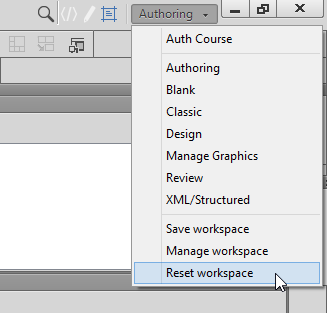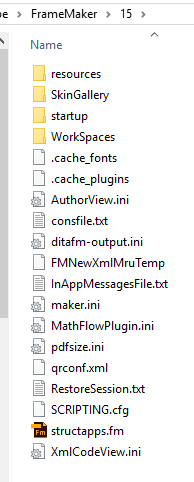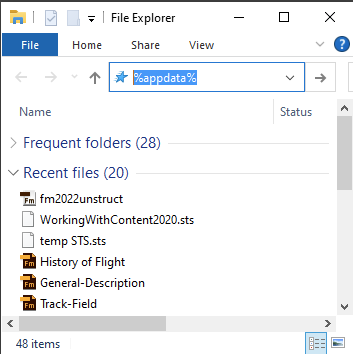
Keeping FrameMaker in tip-top shape
Most applications have settings that, when combined, can confound both novice and expert users. This post is a running tally of things to check if (or when) your FrameMaker experience goes awry. It’s one of my pieces of cornerstone content. View the Cornerstone Content category to check out other key articles.
Updated April 19, 2022 – added info regarding temp file deletion, added info referencing Run as Administrator, and changed text for version reference to 16 to reflect current Fm release
Updated Jan 29, 2020 – added info on reusing preferences folder content
If FrameMaker suddenly acts in new and mysterious ways, you may have shuffled, reorganized, or closed one of the pods that FrameMaker uses to display settings and information. If so, resetting your workspace may restore expected pod locations. If not, you may also have a corrupted preferences file. Follow the procedures below to see if either of these things will remedy your problem.
Resetting your Workspace

Creating a clean Preferences folder
Changing the name of your preferences folder (which forces FrameMaker to write a new preferences folder) is an easy way to check for a corrupted preferences file.
Follow the instructions below to locate the folder, and then change the name of the prefs folder to 16-old, or something similar to see if it resolves your interface issue. If the issue remains, it only takes a minute to delete the new folder, rename the old folder, and restart FrameMaker. You’ll be no worse for having done so.
Locating the Preferences folder
Many preference files are stored in a somewhat obscure location, similar to this:
C:\Users\USERNAME\AppData\Roaming
where USERNAME is the username you use to log into your PC. Inside the Roaming directory, you’ll find a series of folders, including an Adobe directory containing all your Adobe application preferences.
While the structure is fairly easy to navigate, I still get annoyed at shuffling up and down directories whenever I need to access preferences. As a result I long ago discovered that after I drag Roaming into my Favorites in Windows Explorer, things were a bit easier.
There’s also an easy way to navigate directly to the Roaming directory. Just type (or paste) %appdata% into the address bar within a Windows File Explorer instance.
Press the Return key and you’ll display the contents of the Roaming directory.
You can also enter something more specific, like %appdata%\Adobe\FrameMaker\16 into the address bar and you’ll jump straight to your needed location.
Here’s a short video to show how it works.
Recovering workspaces or other things from the previous Preferences folder

Specifically, information about the following may be useful:
- resources
- customized Welcome Screen
- SkinGallery
- customized non-HTML5 output skins
- startup
- may exist if you run plugins that load upon startup (mine are usually from Rick Quatro)
- WorkSpaces
- Contains custom pod locations and menu visibility. These can also be passed across machines to help ensure a consistent editing environment.
- ditafm-output.ini
- customizations to DITA output from Fm
- maker.ini
- A massive dumping ground for preferences within the application. I also suspect this is often the file that corrupts and thus requires recreation, so (re)use with caution.
- structapps.fm
- contains the user-specific definitions for customizations to Structured Applications, the rules that allow you to create structured content.
You are free to copy the older information into your newly minted prefs folder, but (of course) if the assets you are moving are the ones that corrupted your folder, you’ll simply be reintroducing the corruption into your new preferences.
Deleting Temp content
While you’re poking about in the Roaming directory, consider deleting the contents of the directory shown below
C:\Users\”username”\AppData\Local\Temp
While I can’t definitively say this directory has ever been the cause of FrameMaker errors for me, Adobe tech support does recommend it as a potential solution to crashes and/or file opening errors.
Setting FrameMaker to Run as Administrator
Current versions of Windows write-protect files in an application’s install directory. If access to those files prevents FrameMaker functions, including saving changes to your FrameMaker configuration, consider setting FrameMaker to Run as Administrator.
NOTE: Depending on your environment, you may not have permissions on your system to set to Run as Administrator. If not, discuss with your IT staff.
To set FrameMaker to Run as Administrator, right-click on your FrameMaker application icon in the Task bar or in a File Explorer window to choose Run as Administrator.
You may end up with an extra dialog each time you start FrameMaker, but running as administrator is a best practice I recommend, and will allow you to save files that by default are protected during a FrameMaker session.
Did this help you out?
Join the free Tech Comm Tools community and I'll give you a heads-up whenever I've got more content like this that you might like.



